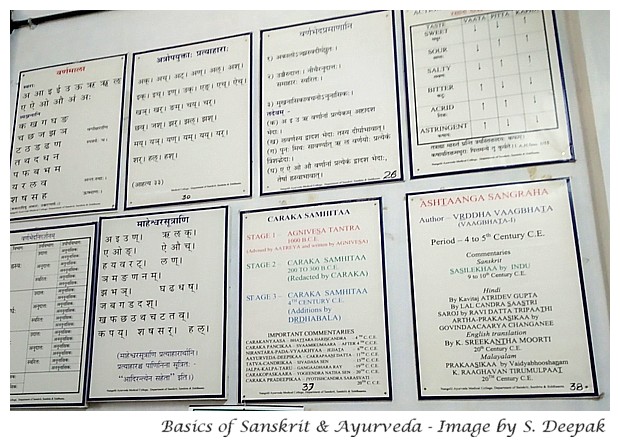Recently I read Dr. Lindsey Fitzharris' 2017 book called "The Butchering Art". It is not a book for the faint-hearted. In this book, she describes the way surgery was done in England till late 19th century and how two discoveries - anaesthesia and antisepsis, revolutionised it. Before those discoveries, surgery was the domain of butchers.
Reading this book raised a question in my mind about surgery in ancient India. More than two thousand years ago, ancient Ayurvedic surgeons were doing different surgeries including full-thickness skin grafts and plastic surgery operations such as rhinoplasty. I have already written a blog post about it. The question in my mind was, how did ancient Indian surgeons resolve the problems of anaesthesia and prevention of bacterial infections during their surgery?
This post is about the Fitzharris' book, as well as, about ideas of anaesthesia and asepsis from the ancient Indian text of Sushrut Samhita.
It was a time when surgery was reserved for desperate and life-saving situations. Surgeons operated on conscious persons, who had to be held on their place by a group of strongmen. The lucky ones lost consciousness and were thus spared the pain of their bodies being opened and their bones being sawed off. The most important quality of surgeons was their speed in finishing the operation.
The Butchering Art
Fitzharris has a vivid way of writing. She brings alive the old and forgotten world of surgery, before the discovery of anaesthesia. Her writing is so graphic, that at times it made me feel a bit queasy. Her book starts on a December day of 1846 and describes one of the first surgeries done under the effect of Ether anaesthesia at the London University College hospital. The surgeon was Robert Liston and on that day, as usual the operation room was full of spectators, who had paid a ticket to watch the show.It was a time when surgery was reserved for desperate and life-saving situations. Surgeons operated on conscious persons, who had to be held on their place by a group of strongmen. The lucky ones lost consciousness and were thus spared the pain of their bodies being opened and their bones being sawed off. The most important quality of surgeons was their speed in finishing the operation.
In the middle of the room was a wooden table stained with the telltale signs of past butcheries. Underneath it, the floor was strewn with sawdust to soak up the blood that would shortly issue from the severed limb. On most days, the screams of those struggling under the knife mingled discordantly with everyday noises drifting in from the street below: children laughing, people chatting, carriages rumbling by. ...
At six feet two, Liston was eight inches taller than the average British male. He had built his reputation on brute force and speed at a time when both were crucial to the survival of the patient. Those who came to witness an operation might miss it if they looked away even for a moment. It was said of Liston by his colleagues that when he amputated, “the gleam of his knife was followed so instantaneously by the sound of sawing as to make the two actions appear almost simultaneous.” His left arm was reportedly so strong that he could use it as a tourniquet, while he wielded the knife in his right hand. This was a feat that required immense strength and dexterity, given that patients often struggled against the fear and agony of the surgeon’s assault. Liston could remove a leg in less than thirty seconds, and in order to keep both hands free, he often clasped the bloody knife between his teeth while working.
In the 1840s, operative surgery was a filthy business fraught with hidden dangers. It was to be avoided at all costs. Due to the risks, many surgeons refused to operate altogether, choosing instead to limit their scope to the treatment of external ailments like skin conditions and superficial wounds. ... The surgeon, wearing a blood-encrusted apron, rarely washed his hands or his instruments and carried with him into the theatre the unmistakable smell of rotting flesh, which those in the profession cheerfully referred to as “good old hospital stink.” ...
At a time when surgeons believed pus was a natural part of the healing process rather than a sinister sign of sepsis, most deaths were due to postoperative infections. Operating theatres were gateways to death. It was safer to have an operation at home than in a hospital, where mortality rates were three to five times higher than they were in domestic settings.
The book starts with discovery of anaesthesia and then quickly moves to its main subject - the ideas of antisepsis and their impact. It tells the story of Joseph Lister and his ideas about prevention of infections during surgery. During 1850s, Louis Pasteur in Paris had come up with the theory of invisible germs which were responsible for souring milk and fermenting grape-juice for making wine. In 1862 he boiled milk, which prevented souring of milk and proved his theory. Lister, who was passionate about microscopes, heard about Pasteur's work and felt that similar microscopic germs were responsible for causing infections in patients during surgery. In 1865 he developed his antiseptic solution based on carbolic acid, and showed that it was possible to reduce the post-operative mortality due to infections.
The book starts with discovery of anaesthesia and then quickly moves to its main subject - the ideas of antisepsis and their impact. It tells the story of Joseph Lister and his ideas about prevention of infections during surgery. During 1850s, Louis Pasteur in Paris had come up with the theory of invisible germs which were responsible for souring milk and fermenting grape-juice for making wine. In 1862 he boiled milk, which prevented souring of milk and proved his theory. Lister, who was passionate about microscopes, heard about Pasteur's work and felt that similar microscopic germs were responsible for causing infections in patients during surgery. In 1865 he developed his antiseptic solution based on carbolic acid, and showed that it was possible to reduce the post-operative mortality due to infections.
Surgery in Ancient India
Sushruta is considered as the father of shalya-chikitsa (surgery) in Ayurveda. Various modern text books on surgery and plastic- surgery acknowledge that some of the techniques described in his treatise "Sushruta Samhita", such as that of full-thickness skin graft and rhinoplasty, have inspired them and are still used. When I read the Fitzharris' book, I wondered how did the ancient Indians develop those surgical skills without modern anaesthesia and antisepsis? To make a full-thickness skin graft or to do rhinoplasty, the surgeons need patients who are calm and can lie still for some time. It was not a work that a person with brute force could do by cutting away a part of the body while others held the patient. Such delicate surgeries would have been wasted if there were post-operative infections. So how did ancient Indian surgeons such as Sushruta do those surgeries?
I searched on internet and found an English translation of the first volume of Sushruta Samhita - it was translated from Sanskrit by an Ayurvedic doctor called Kaviraj Kunjalal Bhishagratna in 1907. In the introduction to the volume, he explained that this was not the original text of Samhita written by Sushruta, rather it was a commented version written by a person called Nagarjuna and was probably written around 3rd or 4th century BCE.
I found some answers regarding the questions of anaesthesia and use of anti-sepsis in surgery in the introduction of this text:
Verses about medicine, hygiene and surgery lie scattered through out the four Vedas. ... There were 5 groups [of healers] - Rogaharas (physicians), Shalyaharas (surgeons), Vishaharas (poison curers), Krityaharas (demon doctors) and Bhisag-Atharvans (magic doctors). (p. 13)
[Sushruta] first classified all surgical operations into different kinds ... Aharya (extraction of solid bodies), Bhedya (excising), Chhedya (incising), Eshya (probing), Sivya (suturing), Vedhya (punturing), and Visravanya (evacuating liquids). ... Sushruta enjoins the sick room to be fumigated with the vapours of white mustard, bdellium, nimva leaves and resinous gums of Shala trees, which foreshadows the antiseptic (bacilli) theory of modern times. (p. 16)
Amputations were freely made and medicated wines were given to patients as anaesthetics. ... In those old days, perhaps there were no hospitals to huddle patients together in the same room and thereby to create artificially septicemic poisons which are now so common and so fatal in the lying-in rooms. A newly built lying-in room in an open space filled with the rays of the sun and the heat of burning fire, and for each individual case the recommendation of a fresh bamboo chip for the section of the [umblical] cord are suggestions the value of which, the west has yet to learn from the east. (p. 19-20)
This brief description shows that in many ways, Ayurvedic surgeons had found solutions to the problems of sepsis and anaesthesia, which had plagued the surgeons in the UK till 19th century. Use of fumigation, sun light, keeping persons separated, using a new and clean cutting instrument, are all ideas that are known to promote antisepsis. Use of medicated wines for anaesthesia needs to be understood better to see which kind of medications were used. My knowledge of Sanskrit is limited but probably there would be more detailed information in the texts of Sushruta Samhita, which can give us more precise answers.
Those understandings of ancient healers like Sushruta were probably based on centuries of observations and experiments, though they had no real understanding of different kinds of bacteria and infectious agents as there were no microscopes to directly observe the micro-organisms. As the quote about different kinds of healers shows, the world of ancient healers was also a world of magic and demons, and thus it is likely that many of the old ideas would be expressed in "unscientific" terms.
Challenges of Understanding Ancient Wisdom
I think that at least some of such ancient understandings were common heritage of humanity and not just limited to India. In large parts of the world such ancient knowledge has been lost because many of the old traditions, along with old gods and their myths were discarded, before they could be codified, written down and preserved for posterity. It is easy to discredit ancient experiential knowledge because it is expressed in unscientific terms and is associated with old myths and ideas of supernatural. In India, in spite of invasions and mixing of cultures, fortunately there has been a civilisational continuity and thus the traditional knowledge in the old texts has been kept alive, and even today Ayurveda is a living tradition, followed by millions of persons.Unfortunately, there is a tendency in India to diminish the importance of Ayurveda and its knowledge, as explained so eloquently in a recent article by Madhulika Banerjee, where she has written:
... my research has shown me several other worlds of Ayurveda — the world of the practising Ayurvedic doctor, the teachers in the scores of colleges and universities of Ayurveda and researchers in different institutes. These worlds are much bigger and deeper, beyond that of Patanjali, Dabur and Himalaya. That world is vibrant, has integrity and it is important that it be known, respected and valued. ... Under the influence of colonialism, we tethered the language, the institutions and the systems of Ayurvedic knowledge production to the margins of our learning and education. We closed many doors and windows of scientific practices within and around traditional medical systems. But in a trick of inversion, we say they do not follow the language and methodology of science.
Despite Ayurvedic knowledge being rooted in a different philosophy, teachers have found ways of keeping up the process of adapting learning from the texts to contemporary education, fitting into modern classifications of anatomy, physiology and higher specialisations at a deeper level. They have both adapted to and adopted new knowledge, widening their horizons unhesitatingly, true to their tradition. Yet they have to face unhappy students, struggling with low self-esteem, under immense pressure to compromise their knowledge.
... When two knowledge traditions have two completely different perspectives on body and disease, then why compete on the medicine and cure? And when parameters of treatment and expected outcomes are of different kinds, then how can the protocols of biomedicine be used for evaluating Ayurvedic medicines? Why can Ayurvedic manufacturing not focus on creating a different world of diagnosis, treatment and cure in keeping with its perspective, expanding the range of choices patients have?
I feel that the last part of Banerjee's quote above is fundamental - the value of the knowledge in Ayurveda can not be and should not be limited to evaluations by "scientists", it also needs to be understood and judged according to its own perspectives. For example, words like dosha, pitta, kapha and vayu, which are fundamental to ideas of Ayurveda, represent complex ideas that can not be translated into illness, bile, mucous and air and then laughed at, because they do not fit our understandings as modern doctors.
As explained in my blog-post on Ganesha story and ancient Ayurvedic techniques of plastic surgery operations on the nose (rhinoplasty), these were copied by British surgeons from India fairly recently (during the last part of 18th century). Yet, that does not stop "modern" doctors from calling Ayurveda as "alternative" medicine or worse, implying that these are inferior knowledge systems, if not outright quackery.
Conclusions
Linda Fitzharris' book on the old surgical art of butchering provides a glimpse into that time when getting a tooth extraction or having an abscess incised could lead to sepsis and death. It was also a time of unimaginable pain as persons were immobilised while the surgeons amputated their limbs or did similar operations. Discovery of anaesthetics and an understanding of spread of infections has led to the world today, where we have advances like laproscopic surgery, laser surgery and robots which can do delicate operations.Forty years ago, when I had studied medicine, I had learned how to use ether anaesthesia for work in rural hospitals which did not have access to a Boyle's machine for anaesthesia. It was still the same technology which Fitzharris has described in her book as taking place in 1846. I don't know if anywhere anyone still uses that primitive approach to anaesthesia! So in way, I could directly identify with that world and feel the horrors of having brutal surgeries without anaesthesia.
It was also enlightening to read the book about Sushruta's techniques of surgery more than 2,500 years ago and appreciate how he and other ancient healers in India had developed an understanding about both anaesthesia and asepsis and were able to conduct and develop complex surgical techniques and to find that some of these techniques were copied in the west fairly recently (in 18th century).
I don't think that Ayurveda and ancient texts like Sushruta Samhita would all make sense according to the modern scientific understandings. They are texts of their times and they would have their parts of myths, stories and fantasies, interspersed with real experiential knowledge. As my brief exposition above shows, they did develop understandings which the modern medicine has developed only relatively recently. They do merit respectful analysis, even when we can't understand their meanings.
End-Note: The images used with this post are from the old anatomy theatre of Bologna in Italy and from an Ayurvedic college in Kerala, India.
End-Note: The images used with this post are from the old anatomy theatre of Bologna in Italy and from an Ayurvedic college in Kerala, India.
*****
#bookreview #surgery #historyofsurgery #ayurvedicsurgery #ayurveda #lindseyfitzharris



























